Mills
The Domesday Book, a survey prepared in England in 1086 AD, lists 5,624 water mills. Many of these mills continue to be mentioned in documents in succeeding centuries. The earliest water mills mentioned were known as Clack or Norse mills which employed a the use of a horizontal wheel unlike the ones that can be seen today which employs a vertical wheel. The early horizontal mills began using an undershot type which worked by water turning blades from the bottom of the wheel. Later, during the Medieval period an overshot method was used whereby water turned the blades from above: this method was much more efficient.
Tidal mills made use of the power of the tide in coastal areas. The earliest tidal mill so far discovered in Europe was excavated at Nendrum, Northern Ireland. It was built in 619-21 for an early Christian monastery. Tidal mills have continued in use until modern times, but were always rare by comparison with standard riverine mills.
Most villages had a mill to grind corn, but this power-source could be turned to other uses. The invention of mechanical fulling by waterpower was apparently introduced to these islands by religious orders, particularly the Cistercians. Fulling mills turned England into a major cloth-making country from the 14th century. They were known as walk mills in northern England and tuck mills in the South-west.
By Tudor times mills were adapted to other industrial uses, such as paper-making, lead-smelting and tanning. The most dangerous of these was gunpowder-making. The risk of violent explosions meant that powder mills were generally sited well away from towns and villages. The Industrial Revolution saw the creation of large-scale spinning mills.

The earliest mention of a mills in Cliffe is in 1228 where Richard de Wallingford, rector of Cliffe, is demanding from the cathedral priory tithes for 2 newly-erected windmills, for 1 watermill*.
Interestingly this records one of the earliest windmills in Kent. It is unknown for certain the location of these windmills however it is possible to believe that the watermill may have been a tidal mill similar to the one noted at Cooling.
Windmills appeared in England from c.1180. A fixed structure would only work if the wind was blowing in the right direction, so the post mill, which could be turned into the wind, was soon preferred. They were often sited high or built on a raised mound to catch more wind. A logical development by the end of the Middle Ages was the tower mill. The tower gave height, and only a cap holding the sails revolved. Smock mills, which arrived by the late 16th century, are similar, but entirely timber-built, whereas the tower type was built of durable brick or stone, so more tower mills survive.
Cliffe - Dance's Mill
Cliffe’s last windmill was a smock windmill and was named ‘Dance’s Mill’ and was sited at the far end of what is now Millcroft Road. Unfortunately there is no surviving photographic record of Dance’s Mill although it’s position is clearly shown on maps from the period. The first map indicating ‘Dance’s Mill’ is by Col. William Mudge in 1801 and there are title deeds for a windmill and associated lands dated from 1700.
Below is a map of 1863 showing both the position of Dances Mill and the Mill House on either side of Mill Road: renamed Millcroft Road.

There is a record of a 'Dance's Mill' lying S.S.E. of the Church at Cliffe which was a black Smock Mill that burnt down around 1885, having stood derelict for some years. The site was built on in 1888, being occupied by Prospect Cottages (apparently two mill stones could be seen supporting the footway to the rear of the cottages. The sweeps reached almost to the ground. At some time around the 1840s it has been reported that a young lad named 'Pope' from Frindsbury was killed by the sweeps after being struck by them.
In 1841 & 1845 Mr George Chapman was recorded as the miller, in 1851 it was Mr. Alfred Buldock and by 1862 the miller was a Mr Alfred Mummery.
William Coles-Finch's wrote a comprehensive book, 'Watermills and Windmills of Kent', published in 1933. Coles-Finch was an engineer from the Medway towns, and started photographing the local mills from 1905. He was particularly strong on the mills of this area, so I doubt he would have got too much wrong, as he often quoted people who remembered mills standing. It is from this excellent study that much of the information on local mills is taken.
It is interesting to note that on early maps the 'road' to the windmill is, what is now, a footpath that runs from the corner of Chancery Road and Quickrill's Ave, behind the school and ending just beyond Millcroft Road. The early references to the way to the mill being by the Mill Road and it is only in the late 1800's that the road to the mill crofts and mill house is now named Millcroft Road.
Dance's Mill stood until a fire broke out c.1885 and much of the mill was destroyed. It lay abandoned until when the remains were put up for auction on 29th October 1887 by Mssrs. Cobb at The Bull Hotel, Rochester. A local Cliffe entrepreneur, Mr. Elford, with a bid of £375 was the successful bidder.
It is not surprising that a number of windmills in Kent have been destroyed by fire. Essentially wooden structures, often tarred externally, they made ready fuel for flames; and once a fire was started there seemed to be no checking it.
A large number of such fires can be attributed to accidental causes but doubtless many a mill has been purposely set alight. Burning up a useless derelict mill solved many a problem for its owner. Worth little or nothing, dangerous in its dilapidated state, "emcumbering the ground," "occupying useful land," unsafe for demolition in any other way, difficulty of getting the Government's sanction for the removal of a landmark perhaps, and the ignoble and fraudulent reralisation of insurance money - these are no doubt some of the true explanations of many a mill fire.
Apart from the windmill at Cliffe mills in the area that also suffered from the same fate include:
Chatham (Luton mill)
Cobham (Darnley's mill)
Frindsbury (Quarry mill)
Gillingham (Stedman's mill)
Gillingham (Huggin's mill)
Rochester (Friday's mill)
Strood (Field's mill)
Higham - Rose's Mill
Sir Richard Head, of Great Hermitage Farm, Higham, had this mill built in 1760. It became known as Rose’s Mill, taking its name from that of the miller.
It was a fine mill and a prominent landmark.
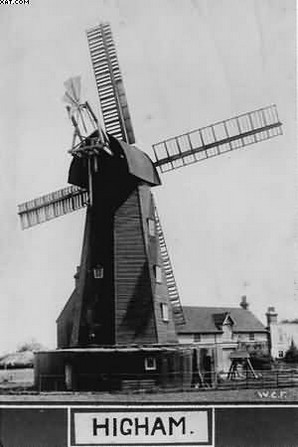
It was principally employed in providing flour for bread supplied to the navy at Chatham during the troublous times of the wars with France. That breadd that was made here is beyond doubt, for the owner of the mill remembered the capacious ovens especially constructed for this purpose, and he himself had made use of one of them for over fifteen years.
There were three pairs of stones, one for the flour and two others for farmers' corn.
Only the base of the mill now remains, which is roofed over and used as a store. The mill had been worked throughout the Great War and for some time afterwards. It was damaged in a storm in March, Later, the fan was blown off in a gale. As with many other windmills, costly repairs could not be afforded by reason of the diminished trade. The mill was therefore pulled down in April, 1921.
The mill was restored and is now a Grade II listed building. It comprises one long range of Mill House, Granary and Cottage, all of 2 storeys with a tiled roof. The Mill House is at the east end. This is stuccoed, has 2 windows, sashes with glazing bars intact and modern porch. The granary in the centre has 4 windows and the cottage at the west end one window. They are both stuccoed on the ground floor and weatherboarded above and have sprocket eaves.
Hoo Common - Ballard's Mill
The mill shown on the 1769 map was evidently a post mill, for the smock mill was built upon the site at c. 1799.
The mill had been found derelict in 1905 and it had been out of use for at least twenty-five years. The sweepless tower, with fan only, was still standing but in a complete state of ruin.
Mrs. R.L. Gardener, who was living at the Mill house in the 1930's, was the grand-daughter of Mr. R. Ballard, the builder and first occupier of the mill, and the only survivor of the Ballard family that had, for three generations, carried on milling operations in Hoo.
The mill was demolished in 1933.
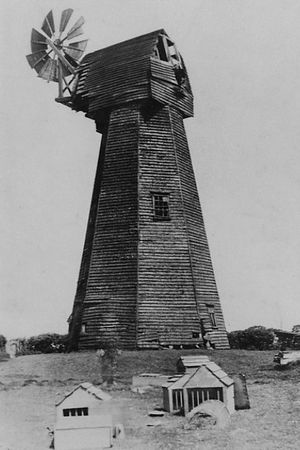
Ballards Mill at Hoo Common
Lower Stoke
Although two mills are to be plainly seen on the 1819-43 map for Lower Stoke William Coles-Finch could only trace points of interest in connection with one of them. It was a fine old ruin when he visited in 1905, with derelict sails and fan. It had a tall brick structure for the base and once had four 'patent' sweeps.
"Some twenty-seven years ago it was occasional work - 'cracking a few beans and doing a bit of work for local farmers.' Since then it fell into diuse and absolute decay. It was taken down a few years ago and the old miller who owned and dismantled it died recently, being nearly 100 years old, which speaks well for a miller's life in the Hundred of Hoo."
Mr. Cooper was the name of the miller referred to and he was a carrier as well as a miller and use to drive his two-horse bus from Stoke to Rochester daily, his son worked the mill in his absence.
Frindsbury Mills
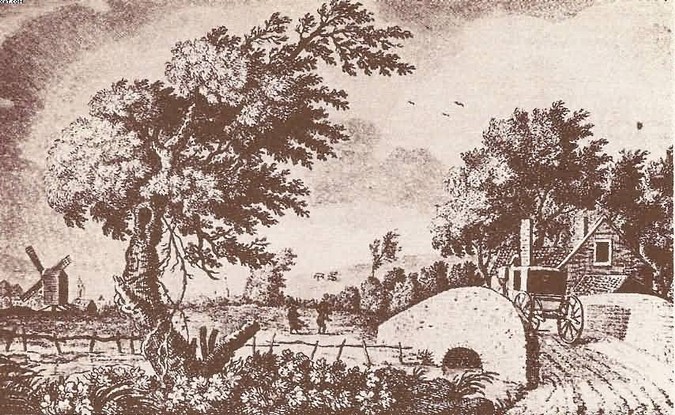
A view of Quarry Mill, Frindsbury c. 1770
Quarry Mill
The first record of a mill shown on a map of Kent is from 1596: this mill was called Quarry Mill in Frinsbury. It was one of the earliest open trestle, or tripod mills in Kent - that is, one sitting on a central post braced to the ground with a large tail which enabled it to be turned to the wind. Sometime about 1850 during a great storm it "ran away" : friction caused overheating which resulted in it being burnt to the ground. It was never rebuilt.
Little Mill (Manwaring's Mill)
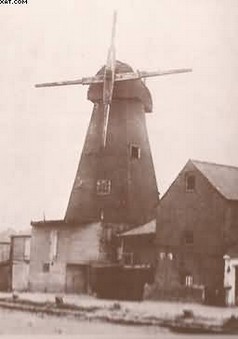
On top of Prospect Hill stood two windmills: The Little Mill or Manwaring's Mill and The Great Mill or Rose's Mill.
Little Mill was built c.1769 for a Mr. Baldock but was often known as Manwaring's Mill after Thomas Manwaring who owned it for eleven years from 1843 to 1854, it later became known as Little Mill even though ity wasn't a small structure by any means - it drove four sets of stones! It was a black tarred smock mill with one floor under the stage, which was very narrow and having no railing. No flour was made at this mill but ground corn was transferred to the Great Mill to produce high class flour. It got it's name due to being somewhat dwalfed by its neighbour, the Great Mill.
The Great Mill (Rose's Mill)
 The Great Mill or Rose's Mill was reputed to be the highest in Kent. It was a large mill with three floors under the stage and sweeps or sails over nine feet wide and forty feet long driving four sets of 4½ feet stones capable of turning out 250 bags of flour a week. An unusal feature of this mill was that its interior was lathed and plastered and it had staircases as in a dwelling house.
The Great Mill or Rose's Mill was reputed to be the highest in Kent. It was a large mill with three floors under the stage and sweeps or sails over nine feet wide and forty feet long driving four sets of 4½ feet stones capable of turning out 250 bags of flour a week. An unusal feature of this mill was that its interior was lathed and plastered and it had staircases as in a dwelling house.At one point it was thought of introducing a further set of stones, making six pairs in all, but, although the the mill was reckoned to be powerful enough, there was not sufficient room for the additional installation.
Both mills were taken over by Mr Kimmins in about 1845 who owned all the surviving mills in Frindsbury: he also owned a number of steam mills in and around Medway.
The end came for Little Mill in 1886 when, after being struck by lightening, was cleared away.
The Great Mill had, what some may say, a sadder end. It was pulled down in 1890 much to the regret of the local community to leave way for the lower part to be converted into two substanial cottages. These have now gone and only the Mill House remains.
Kimmin's Mill
Kimmin's Mill, built in 1825, once stood towards the top of Bingham Road. It was a smock mill without a base which meant that the sweeps came almost to the ground and this resulted in the death of a man who ventured too close. The mills was only used for grinding pollard and there were two pairs of stones and four 'common' sails. The millwas pulled down in 1865.
House Mill
This mill was known as House Mill as it was close to the home of the owner, Mr. Kimmins. It was also known as Frindsbury Mill and Kimmin's Mill. It too was a black smock mill working four pairs of stones which were driven 'underdrift'. All the meal ground was taken to a steam mill adjoining and dressed there. It stood on Frindsbury Hill, near Bill Street Road, opposite Prospect Hill, on the road to Higham.
It stood derelict for about thirty years before it was finally demolished in 1931.
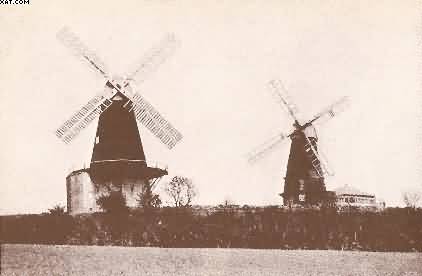
The Prospect Hill Mills: the Little Mill, and the Great Mill, Frindsbury. Source@ W.C.F
Sources
- Brown, R.J., Windmills of England (1976). Gazetteer of survivals.
- Bryan, T., Windmill Gazetteer for England (The Mills Research Group 1998). Lists all windmill sites in England with remains over 600mm high.
- Greenwood, J., Tidemills in England and Wales
- Hicks, C., The Industrial Archaeology of Gunpowder Mills.
- Holt, R., The Mills of Medieval England (1988).
- Kealey, E.J., Harvesting the Air (1987).
- Lindsey, C.F., Windmills: a bibliographical guide (1974).
- Watts, M., The Archaeology of Mills and Milling(2002).
- Wenham, P., Watermills (1989). Includes gazetteer.
- West, J., Windmills of Kent, 2nd edn. (1979).
